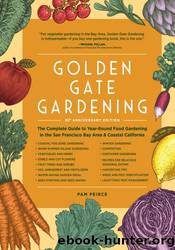Golden Gate Gardening, 30th Anniversary Edition by Pam Peirce

Author:Pam Peirce [Peirce, Pam]
Language: eng
Format: epub
Published: 2023-08-15T00:00:00+00:00
Collards
Plants started in late summer usually flower by February or March. Spring planted ones often flower in summer. For some, the appearance of small side shoots that will bear flowers marks the time to pull the plants out. But I have learned that the young shoots are a delicious vegetable. I keep them picked before the flower buds open and either steam them as I would the leaves or use them in ways that one uses broccoli raab or gai lan, or in stir-fries, curries, or omelets. The plants may look awful, but they keep bearing these tender shoots for months.
If you let seedpods form, shoot production will slow, but if seed forms, it is easy to save. You may need to put a mesh bag over the stems to keep birds from eating the seeds.
Varieties Almost any collard variety will do well here. Seeds given to me by another gardener, surprised me with an occasional purple-tinged plant. Most varieties grow 2 to 3 feet high, with seed stalks reaching about 5 feet high. A tall perennial type, commonly called tree collards, may grow to 10 feet or more. Usually grown from cuttings, tree collards can be planted in February and picked whenever it isnât going to seed. Prune the stems in late summer. Many enjoy tree collards, but I found the leaves unpleasantly tough.
Pests Collards share all of the mustard-family pests (see this page).
Sources
Collard seed: Widely available
Tree collard seed: SIS
Tree collard plants: AA, TERR
Corn, Sweet and Popcorn
Zea mays
Grass Family â Poaceae (Graminae)
Corn is a warm-season crop that produces consistently in all but the foggiest parts of the region. You can grow early varieties even in sunnier San Francisco neighborhoods. Where summer is too cool, corn may form tassels and silks at different times. If the male flowers in the tassels and the female flowers in the ears are not ready at the same time, there will be no fertilization and thus no corn. Very hot weather, above 95°F for an extended period, will slow the corn plant growth and may delay silk readiness for fertilization until pollen is gone. Once fertilization takes place, the ambient temperature doesnât affect the sweetness of the corn.
Growing Instructions Corn expects the red-carpet treatmentâsunshine, good rich soil, and ample water. Add plenty of compost or well-rotted manure at planting time and boost with high nitrogen fertilizer, especially if lower leaves begin to yellow. Corn that dries until leaves curl will be stunted.
Direct-seed corn anytime from April 15 to the middle of July. A foot between plants is the usual recommended distance. If corn varieties with standard-sized plants are spaced closer than 8 to 10 inches apart, they will bear fewer and poorly filled out ears. Ample spacing is especially important when fog limits the amount of light. Plant the seeds 1½ to 2 inches deep. I usually plant two kernels in each spot, spacing them 1 or 2 inches apart. When the plants are 3 or 4 inches high, I pull the extras or transplant them to fill gaps left by poor germination or pest damage.
Download
This site does not store any files on its server. We only index and link to content provided by other sites. Please contact the content providers to delete copyright contents if any and email us, we'll remove relevant links or contents immediately.
| Container Gardening | Hydroponics |
| Organic | Propagation & Cultivation |
| Topiary | Urban |
| Water Gardens & Ponds |
Turbulence by E. J. Noyes(7059)
The Thirst by Nesbo Jo(5795)
Gerald's Game by Stephen King(3928)
Be in a Treehouse by Pete Nelson(3234)
Marijuana Grower's Handbook by Ed Rosenthal(3126)
The Sprouting Book by Ann Wigmore(3057)
The Red Files by Lee Winter(2923)
The Remains of the Day by Kazuo Ishiguro(2627)
Sharp Objects: A Novel by Gillian Flynn(2452)
Christian (The Protectors Book 1) by L. Ann Marie(2396)
Organic Mushroom Farming and Mycoremediation by Tradd Cotter(2314)
The Culinary Herbal by Susan Belsinger(2063)
Stone Building by Kevin Gardner(1998)
The Starter Garden Handbook by Alice Mary Alvrez(1930)
Lilac Girls by Martha Hall Kelly(1883)
The Unlikely Pilgrimage of Harold Fry by Rachel Joyce(1838)
The Lean Farm Guide to Growing Vegetables: More In-Depth Lean Techniques for Efficient Organic Production by Ben Hartman(1789)
Urban Farming by Thomas Fox(1752)
Backyard Woodland by Josh VanBrakle(1591)
